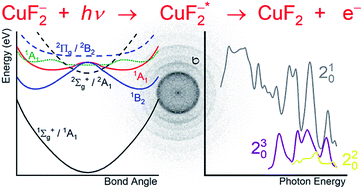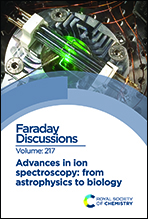Spectroscopy of temporary anion states: Renner–Teller coupling and electronic autodetachment in copper difluoride anion
Abstract
Photoelectron angular distributions determined in small energy increments between 3.522 and 3.650 eV reveal distinctly different detachment mechanisms within the CuF2−(X 1Σ+g) → linear CuF2(X 2Σ+g) + e− band. Certain channels also display non-Franck–Condon behaviour, the action spectra of which reveal rich structure. The behaviour reflects excitation to an electronically unbound anion state (at the linear geometry). The effects of the intermediate state are observed in the detachment behaviour at photon energies down to the X 1Σ+g → X 2Σ+g threshold. Adiabatic CAP-EOM-CCSD (equation of motion coupled cluster singles and doubles, including a complex absorbing potential) energy curves are presented along the bending coordinate, showing the complexity of anion and neutral states for this system. The photodetachment action spectra represent a spectroscopic probe of the vibronic state energies in the vertical excitation region and highlight the need for treatment of vibronic coupling in systems involving the loss of an electron.

- This article is part of the themed collection: Advances in ion spectroscopy - from astrophysics to biology


 Please wait while we load your content...
Please wait while we load your content...